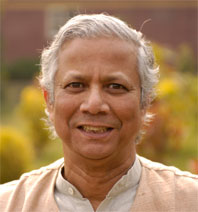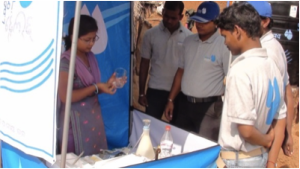
Mohammad Yunus is a nice man. He’s also very smart, innovative, a risk-taker — and a winner of the Nobel Prize for Peace. However, he is sometimes wrong. And he’s most certainly wrong when he insists, as he has done so frequently in recent years both in his books and in public appearances, that the solution to global poverty lies in forming “social businesses” that never distribute profits to investors.
“Poverty should be eradicated,” Yunus asserts, “not seen as a money-making opportunity.” He believes that investors in social businesses should only get their money back. In my view, that adds up to a sizable interest-free subsidy, which constrains the potential for scale. In other words, the “solution” he advocates is no solution at all, since it limits the appeal to philanthropists who are willing to loan money at zero interest and hope for repayment in depreciated funds.
 Philanthropy can accomplish many good things. But can’t eradicate poverty. There’s simply not enough philanthropic money available on Planet Earth to transform the lives of the 2.7 billion people who live on $2 a day or less.
Philanthropy can accomplish many good things. But can’t eradicate poverty. There’s simply not enough philanthropic money available on Planet Earth to transform the lives of the 2.7 billion people who live on $2 a day or less.
The microfinance movement and the combined work of International Development Enterprises (iDE) have probably helped about 50 million extremely poor people move out of poverty. Even if that number is twice as large, or 100 million, it amounts to less than 4% of the 2.7 billion living in poverty. This is pitiful!
How can we successfully achieve scale?
I define meaningful scale as any strategy or initiative capable of helping a minimum of 100 million people living $2 a day move out of poverty by at least doubling their income. We urgently need to find ways to bring to scale the few comparatively successful models for development that are available.
What are the common features of initiatives that have truly helped extremely poor people move out of poverty?
- They begin by thoroughly listening to poor customers and thoroughly understanding the specific context of their lives.
- They design and implement ruthlessly affordable technologies or business models.
- Energizing private sector market forces plays a central role in their implementation.
- Radical decentralization is integrated into economically viable last-mile distribution.
- Design for scale is a central focus of the enterprise from the very beginning.
Mal Warwick and I describe these concepts in detail in our recent book, The Business Solution to Poverty.
It is clear that all of these factors are integral components of a business system, but this takes us back to the original question: should it be a business system that enhances the livelihoods of poor people without making a profit for outside investors? Or should it make a profit for investors as well as the poor people who are served by it?
To me the answer is obvious. The only way for a business to help at least 100 million poor people move out of poverty is to follow the laws of basic economics, which means providing an opportunity for both poor and rich investors to earn what they consider to be an attractive profit from their participation.
I have no doubt that there are huge profitable virgin markets all over the world serving $2-a-day customers waiting to be tapped. By the laws of economics, creating a new market requires taking a very large risk, and the reward should be commensurate with the risk. If the new venture is successful, all the investors – the poor customer who buys the product, the shopkeeper who sells it, the company employee who makes or transports the product or manages the supply chain, and all the financial investors in the company – should make attractive profits.
Here is an example: Coal contributes 40% of global carbon emissions and releases millions of tons of heavy metals and other pollutants every year, worsening climate change and sickening people around the world. Properly carbonized biomass can be substituted for coal and co-fired alongside it in proportions up to 80%. The world’s farmers produce four billion tons of agricultural waste each year. If 100 million tons of this agricultural waste could be effectively and affordably carbonized in decentralized rural settings, a multinational enterprise finding a cost-effective way to make it happen could reach global sales of $10 billion a year within five to ten years. Such a company would not only provide attractive profits to investors willing to take on the substantial risk involved, but would furthermore double the incomes of at least 100 million $2-a-day enterprise participants in developing countries.
 The only way a company like this can reach scale is with the financial backing of for-profit venture investments. And the only way to justify those comparatively high-risk, early-stage investments is if the company provides the opportunity to make exceptionally good profits if it succeeds.
The only way a company like this can reach scale is with the financial backing of for-profit venture investments. And the only way to justify those comparatively high-risk, early-stage investments is if the company provides the opportunity to make exceptionally good profits if it succeeds.
We have two options. One is to keep hoping that governments will come through with billions of new aid dollars, keep asking individuals to dig deeper for charity dollars, and hope that the low-or-no-profit venture capital space Mohammad Yunus profers takes off and becomes a truly global phenomenon. We could plod along full of hope but low on results, celebrating increases in impact of fractions of a percentage point.
The other option is to blend the designer’s sensibility, the artist’s creativity, the ground-level aid worker’s understanding of local context, and the entrepreneurs’ dynamism and drive for success, and create profitable global companies that serve poor customers with products and services that help them rise out of poverty. We could unleash the full power of the greatest force in human history – profit – and start ending poverty by the hundreds of millions.
It would be immoral to do anything else.

Not allowing for profits feels like planting a seed in a latrine. It might have a great opportunity to sprout but will not be able to reach its full potential.
Great points. But it’s hard to find the right tech that can make a business at BoP. I came across this startup from Univ of Washington – Carbon Cultures — http://carboncultures.com/ — creators of a pyrolysis “blanket” that turns forest waste (slash piles) into biochar. What do you think of this tech? It seems to fit many of the needed criteria for scalability.
Mr. Polak,
I’m 100% in support of your thinking. I have been a fan of Dr. Yunus for a long time but I now don’t think his good intentions are enough to eradicate poverty in the world. I have been thinking of doing carity work after my retirement but I longer believe that charity will save the world. I am now thinking of going into business to serve the 2.7 B, in the bottom of the pyramid. I am a serious student of yours and I’m reading all your books. Thank you.
~Bab
Thanks Paul for a great article,you have opened my mind on how i can play my part to reduce poverty in my community,i promice that I will give feedback on what I am goin to do.
While I agree it is not a silver bullet does it mean the idea has no merit? I don’t believe so. Let’s put the developed world at 1 billion people which is about right. If each of those people gave $10 a month that would be $10 billion a month. Even just spread between 2.7 billion it would nearly triple their monthly salary. But that’s pure charity and I don’t believe that helps in a sustainable way. So you give it to third world companies who use it as a loan for business and yes they take a profit for themselves too. That is the way companies like Kiva work. The charity from the western backer is minimal because it’s just interest lost. but what it does is allow a lot more capital to flow and go to those who are a bit more of a risk. Therefore it is actually allowing 2 companies to grow and the loan company can use it’s profits to make more loans of its own furthering the growth.
Robert, thank you for your comment. I wish the solution you propose were feasible. Unfortunately, getting 1 billion people each to donate $10 a month simply won’t happen. Nor could governments levy taxes on them all to accomplish the same end. It’s a nice fantasy, but sadly the world doesn’t work that way.
Agree with the concept and rationale.
It’s important though that the enterprises serving BoP be seeded and scaled as far as possible from within the BoP population.
Large global enterprises have the resources to invest (whether it’s investment into research for development of a new cost effective product for low income groups or investment to scale up long before greater scale converts into better returns) which entrepreneurs from the same BoP population lack but it’s these entrepreneurs who understand best what is needed.
This process of change can be accelerated manifold if large global enterprises ‘seed’ or ‘incubate’ such for-profit enterprises led by people from the same BoP population.
The reason there are more turkeys than eagles in the world is that we eat turkeys therefore it is in our best interest to breed and raise them. We are motivated.
The same is true of profits. They motivate people.
We can wish the world was totally altruistic but that is not the case. Profit works to solve problems.